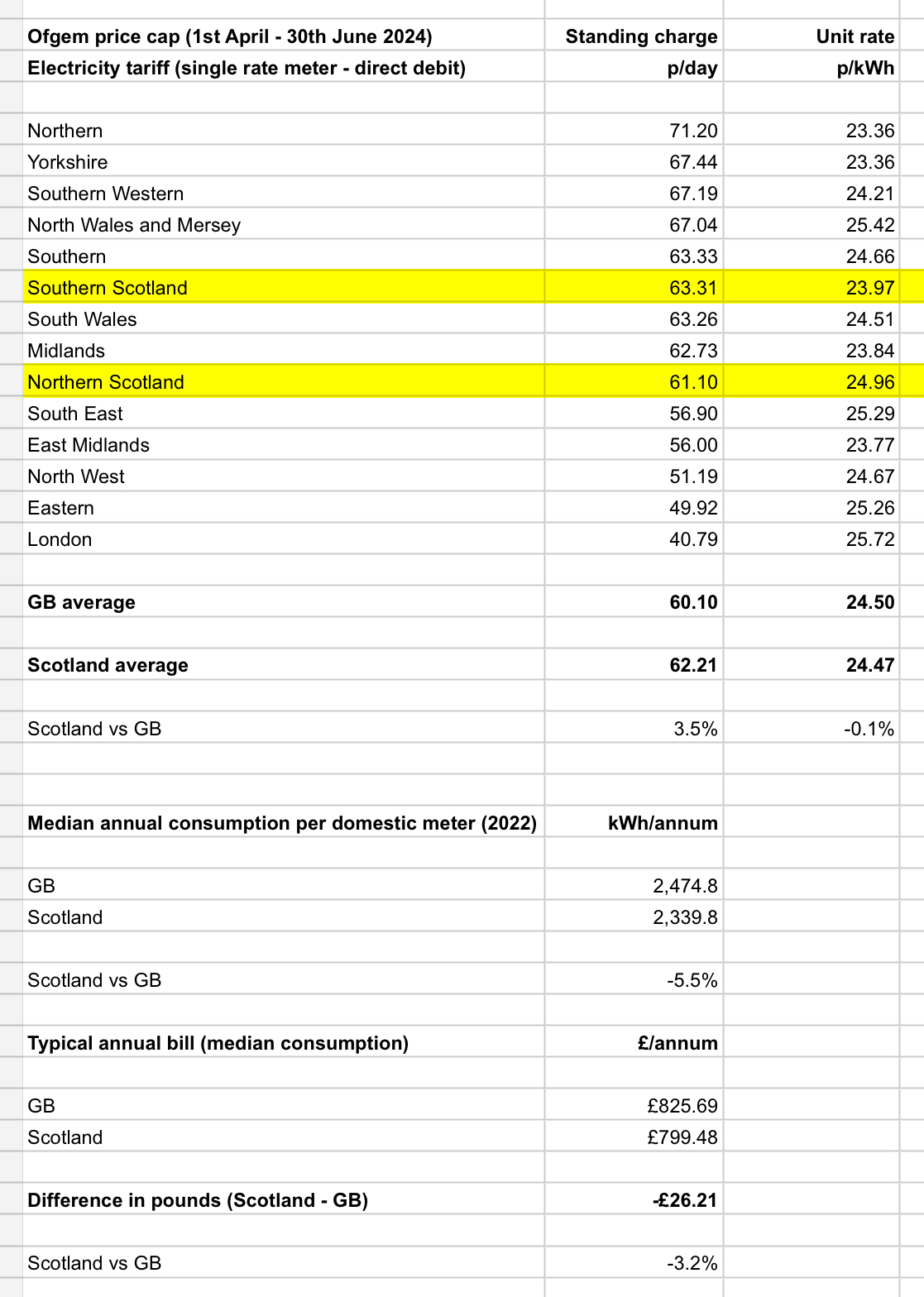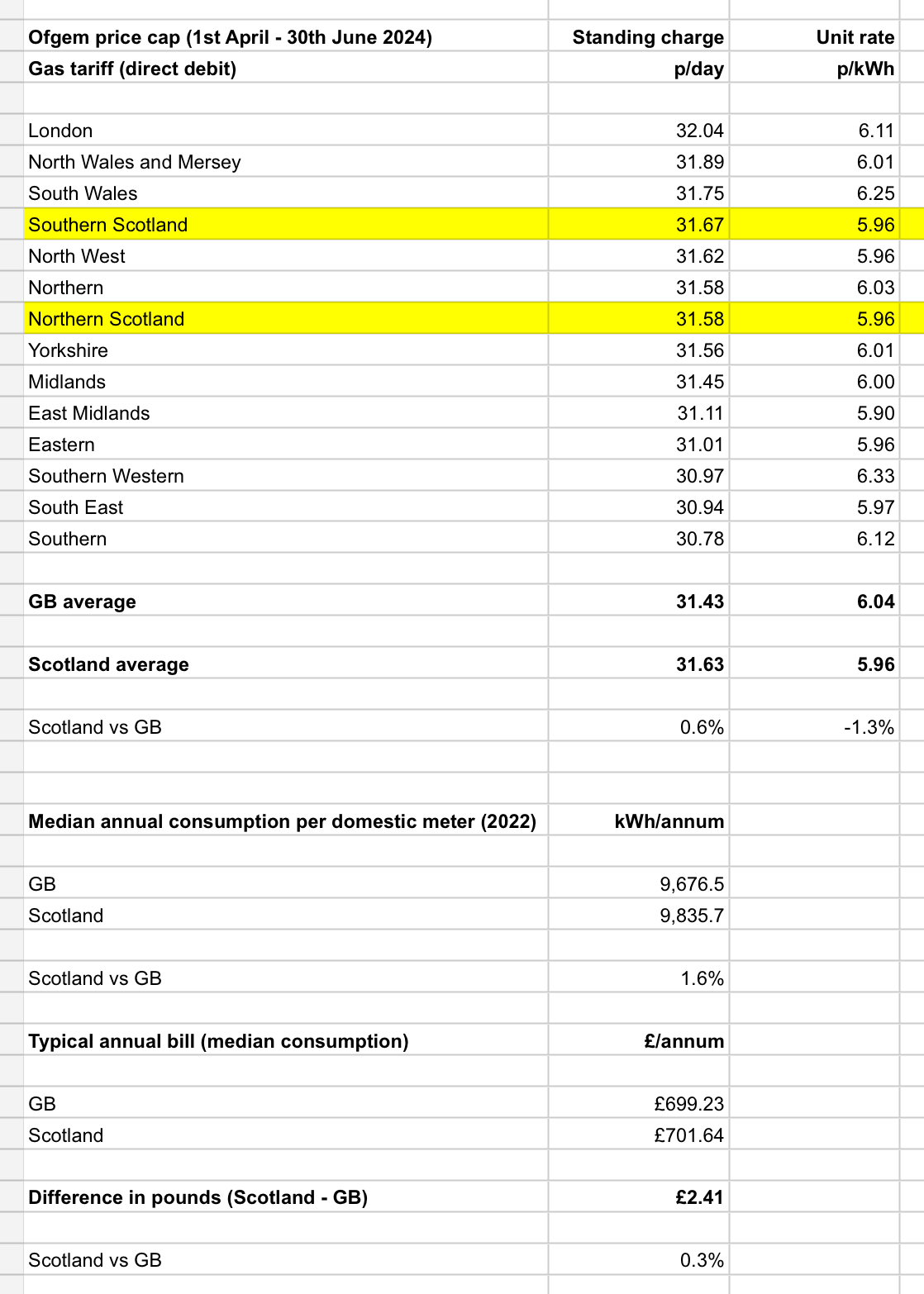SWINGS AND ROUNDABOUTS
03 April 2024
One of the most pernicious myths in Scottish political debate concerns the supposedly unfair household electricity tariffs which apply in Scotland, particularly in relation to standing charges.
Historically, standing charges for electricity in Scotland have been higher than the GB average. The figures moved around from period to period, as Ofgem price caps changed. But compared to the GB average, Scotland tended to have noticeably higher (although not the highest) standing charges.
However, what those complaining about the higher standing charge rarely (if ever) mentioned was that unit rates for electricity (by far the largest component of bills) were noticeably lower in Scotland than the GB average.
Once you factored in typical consumption, these two effects - higher standing charge, lower unit rate - almost perfectly cancelled each other out. Average household electricity bills in Scotland were always very close to the GB average.
Under the new Ofgem price cap1https://www.ofgem.gov.uk/information-consumers/energy-advice-households/get-energy-price-cap-standing-charges-and-unit-rates-region, which came into effect on 1st April 2024, the basic facts do not change: average household electricity bills in Scotland will continue to be very close to the GB average. But the narrative will change.
The new price cap materially increases electricity standing charges in most regions, but increases them only slightly in Scotland. And unit rates go down materially across the board, but go down slightly less in Scotland. There is always a trade off between the two components. The net effect is that all regions will remain in a fairly tight band once you arrive at total bills.
However, it can no longer be argued that electricity standing charges in Scotland are noticeably higher than the GB average.
Here is the new Ofgem price cap electricity tariff, with the regions ordered from highest to lowest standing charges. Notice that Scotland is now bang average. Its two regions are squarely in the middle of the pack.

And conversely, unit rates in Scotland are now very close to the GB average too.
Electricity standing charges in Scotland are now fractionally higher than the GB average. But are the SNP really going to argue that a 3.5% difference is some terrible injustice? They will doubtless try.* But to any sane observer, these are immaterial differences.
Once you factor in median domestic electricity consumption2https://www.gov.uk/government/statistics/regional-and-local-authority-electricity-consumption-statistics, which is 5.5% lower than the GB average in Scotland, the average Scottish household will actually pay £26.21 less per year for electricity than the average GB household. In percentage terms, that means average household electricity bills 3.2% lower in Scotland than the GB average.
The situation for gas is shown below, again with the regions ordered from highest to lowest standing charges.

Standing charges for gas are in a much tighter range than for electricity, and the two Scottish regions are marginally higher than the GB average. But notice that unit rates for gas in Scotland are the lowest of any GB region.
Median domestic gas consumption3https://www.gov.uk/government/statistics/regional-and-local-authority-gas-consumption-statistics is slightly (1.6%) higher in Scotland than the GB average. But because the tariff is more favourable, the average household gas bill in Scotland will be just 0.3% above that of the average GB household, or £2.41 more per year.
And so an average dual-fuel household in Scotland will pay about £24 less per year for gas and electricity than the average GB household. Average household energy bills will be 1.6% lower in Scotland than the GB average. The boring and unremarkable truth is that average household energy bills will be basically the same across all GB nations and regions. Just as they always have been.
*They will probably complain that standing charges in Scotland remain materially higher than in London, which has the lowest standing charge of any GB region. But what they won’t mention is that London has the highest unit rates of any GB region. It’s all swings and roundabouts.
Please log in to create your comment